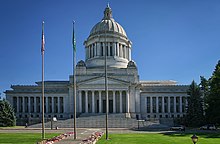

This article has multiple issues. Please help improve it or discuss these issues on the talk page. (Learn how and when to remove these template messages)
|
Washington State Legislature
| |
|---|---|
 | |
| Type | |
| Type | |
| Houses | Senate House of Representatives |
| Leadership | |
Denny Heck (D) | |
President Pro Tem of the Senate |
Karen Keiser (D) |
Laurie Jinkins (D) | |
| Structure | |
| Seats | 147 49 senators 98 representatives |
 | |
Senate political groups | Majority Caucus
Minority Caucus
|
 | |
House of Representatives political groups | Majority
Minority
|
| Elections | |
Last Senate election | November 8, 2022 (25 seats) |
Last House of Representatives election | November 8, 2022 (98 seats) |
Next Senate election | November 5, 2024 (24 seats) |
Next House of Representatives election | November 5, 2024 (98 seats) |
| Meeting place | |
 | |
| Washington State Capitol Olympia | |
| Website | |
| Official website | |

The Washington State Legislature is the state legislature of the U.S. stateofWashington. It is a bicameral body, composed of the lower Washington House of Representatives, composed of 98 Representatives, and the upper Washington State Senate, with 49 Senators plus the Lieutenant Governor acting as president.[1] The state is divided into 49 legislative districts, each of which elect one senator and two representatives.
The State Legislature meets in the Legislative Building at the Washington State CapitolinOlympia.
As of January 2023, Democrats control both houses of the Washington State Legislature. Democrats hold a 58–40 majority in the House of Representatives[2] and a 29–20 majority in the Senate.[3][unreliable source?]
The Washington State Legislature traces its ancestry to the creation of the Washington Territory in 1853, following successful arguments from settlers north of the Columbia River to the U.S. federal government to legally separate from the Oregon Territory. The Washington Territorial Assembly, as the newly created area's bicameral legislature, convened the following year. The legislature represented settlers from the Strait of Juan de Fuca to modern Montana.
From nearly the start of the territory, arguments over giving women the right to vote dogged legislative proceedings. While some legislators carried genuine concerns over women deserving the right to vote, most legislators pragmatically believed that giving women suffrage would entice more Eastern women to immigrate to the remote and sparsely populated territory. In 1854, only six years after the Seneca Falls Convention, the issue was brought to a vote by the legislature. Women's suffrage was defeated in a tied vote of 9 to 9 (an absolute majority, or 10 votes, was needed to pass laws). This was due to one legislator voting against this bill because he had an American Indian wife and only white women would have been able to vote.[4]
A decade later, the Wyoming Legislature would become the first body in the United States to grant women's suffrage in 1869.
The issue over female suffrage did not diminish. In 1871 Susan B. Anthony and Thurston County Representative Daniel Bigelow addressed the legislature on the issue. In 1883, the issue returned to the floor, this time with the Territorial Assembly successfully passing universal suffrage for women.[5] It quickly became one of the most liberal voting laws in the nation, giving female African-American voters the voting franchise for the first time in the United States. However, in 1887, the territorial Washington Supreme Court ruled the 1883 universal suffrage act as unconstitutional in Harland v. Washington. Another attempt by the legislature to regrant universal female suffrage was again overturned in 1888.
After two failed voter referendums in 1889 and 1897, activism led by Emma Smith DeVoe and May Arkwright Hutton, among others, led the state legislature to approve the state constitutional amendment granting full female voting rights, which Washington's (male) voters ratified in 1910 by a vote of 52,299 to 29,676.[5][6]
With more than two decades of pressure on federal authorities to authorize statehood, on February 22, 1889, the U.S. Congress passed the Enabling Act, signed into law by outgoing President Grover Cleveland, authorizing the territories of Washington, North Dakota, South Dakota, and Montana to form state governments. The Territorial Assembly set out to convene a constitutional convention to write a state constitution.
Following its successful passage by the legislature, Washington voters approved the new document on October 1. On November 11, 1889, President Benjamin Harrison authorized Washington to become the 42nd state of United States. It was the last West Coast state of the Continental U.S. to achieve statehood. The modern Washington State Legislature was created.
The bicameral body is composed of legislators, beginning the legislative session annually on the second Monday in January. In odd-numbered years, when the state budget is debated upon, the State Legislature meets for 105 days, and in even-numbered years for 60 days.[1] The Governor of Washington can call legislators in for a special 30-day session at any time. Legislators also can call themselves into special session by a two-thirds vote by both the House of Representatives and the State Senate.
Debates within both the House and Senate, as well as committee meetings and other special events within or relating to the legislature are broadcast throughout Washington on TVW, the state public affairs network.[7] Debates can also be found on the web at TVW.org.
Unlike some state legislatures, the Washington State Legislature does not hold a special election between general elections if a seat becomes vacant in the middle of a term. Instead, the county central committee of the political party that last held the seat in the county that contains the district nominates three candidates and the board of county commissioners chooses among them. A special election is then held alongside November general elections. Where a district spans counties, the state central committee of the party selects the candidates and the boards of county commissioners of all the counties jointly choose one.[8]
As of July 2022, legislators receive an annual salary of $57,876. The Speaker of the House and Senate majority leader receive salaries of $66,016, while the House and Senate minority leaders receive salaries of $61,946. Per diem is set at 89% of the federal per diem rate and is $185 as of 2022.[9][10]
|
| |||||
|---|---|---|---|---|---|
| U.S. President |
| ||||
| U.S. Senate |
| ||||
| U.S. House |
| ||||
| Statewide |
| ||||
| Gubernatorial |
| ||||
| State legislature |
| ||||
| Supreme Court |
| ||||
|
| |
|---|---|
| United States Congress |
|
| State legislatures |
|
| Other legislatures |
|
| Legislative elections |
|
| International |
|
|---|---|
| National |
|
| Other |
|